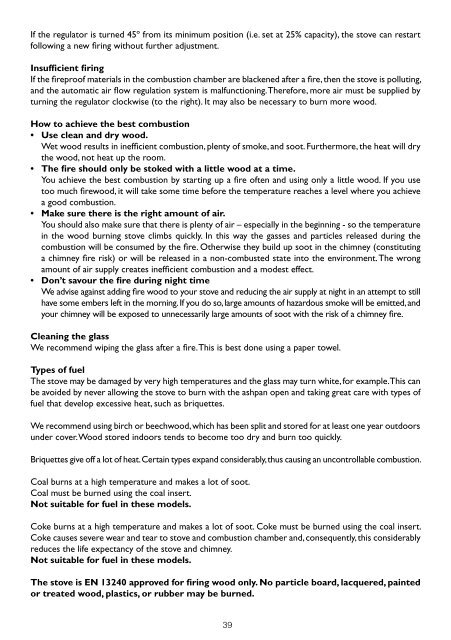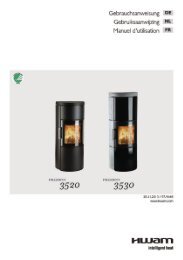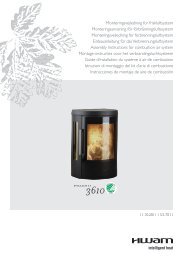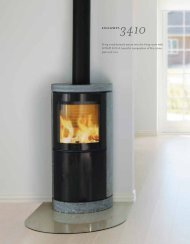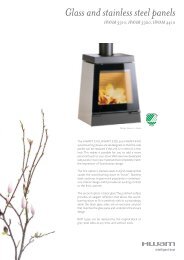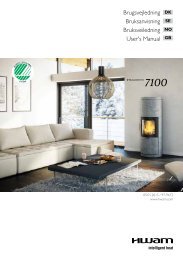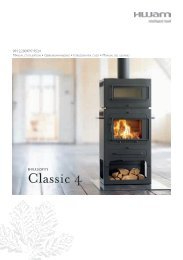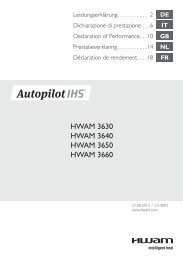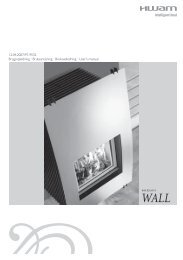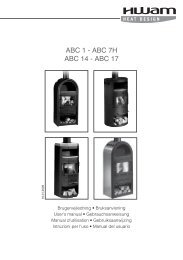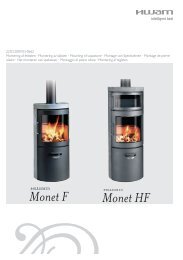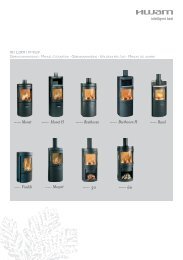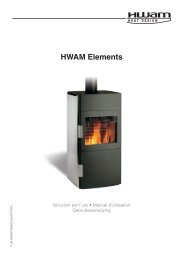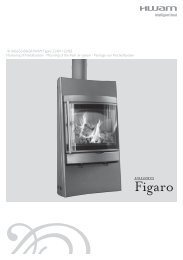prøvningsattest - Hwam
prøvningsattest - Hwam
prøvningsattest - Hwam
Create successful ePaper yourself
Turn your PDF publications into a flip-book with our unique Google optimized e-Paper software.
If the regulator is turned 45º from its minimum position (i.e. set at 25% capacity), the stove can restart<br />
following a new firing without further adjustment.<br />
Insufficient firing<br />
If the fireproof materials in the combustion chamber are blackened after a fire, then the stove is polluting,<br />
and the automatic air flow regulation system is malfunctioning. Therefore, more air must be supplied by<br />
turning the regulator clockwise (to the right). It may also be necessary to burn more wood.<br />
How to achieve the best combustion<br />
• Use clean and dry wood.<br />
Wet wood results in inefficient combustion, plenty of smoke, and soot. Furthermore, the heat will dry<br />
the wood, not heat up the room.<br />
• The fire should only be stoked with a little wood at a time.<br />
You achieve the best combustion by starting up a fire often and using only a little wood. If you use<br />
too much firewood, it will take some time before the temperature reaches a level where you achieve<br />
a good combustion.<br />
• Make sure there is the right amount of air.<br />
You should also make sure that there is plenty of air – especially in the beginning - so the temperature<br />
in the wood burning stove climbs quickly. In this way the gasses and particles released during the<br />
combustion will be consumed by the fire. Otherwise they build up soot in the chimney (constituting<br />
a chimney fire risk) or will be released in a non-combusted state into the environment. The wrong<br />
amount of air supply creates inefficient combustion and a modest effect.<br />
• Don’t savour the fire during night time<br />
We advise against adding fire wood to your stove and reducing the air supply at night in an attempt to still<br />
have some embers left in the morning. If you do so, large amounts of hazardous smoke will be emitted, and<br />
your chimney will be exposed to unnecessarily large amounts of soot with the risk of a chimney fire.<br />
Cleaning the glass<br />
We recommend wiping the glass after a fire. This is best done using a paper towel.<br />
Types of fuel<br />
The stove may be damaged by very high temperatures and the glass may turn white, for example. This can<br />
be avoided by never allowing the stove to burn with the ashpan open and taking great care with types of<br />
fuel that develop excessive heat, such as briquettes.<br />
We recommend using birch or beechwood, which has been split and stored for at least one year outdoors<br />
under cover. Wood stored indoors tends to become too dry and burn too quickly.<br />
Briquettes give off a lot of heat. Certain types expand considerably, thus causing an uncontrollable combustion.<br />
Coal burns at a high temperature and makes a lot of soot.<br />
Coal must be burned using the coal insert.<br />
Not suitable for fuel in these models.<br />
Coke burns at a high temperature and makes a lot of soot. Coke must be burned using the coal insert.<br />
Coke causes severe wear and tear to stove and combustion chamber and, consequently, this considerably<br />
reduces the life expectancy of the stove and chimney.<br />
Not suitable for fuel in these models.<br />
The stove is EN 13240 approved for firing wood only. No particle board, lacquered, painted<br />
or treated wood, plastics, or rubber may be burned.<br />
39


